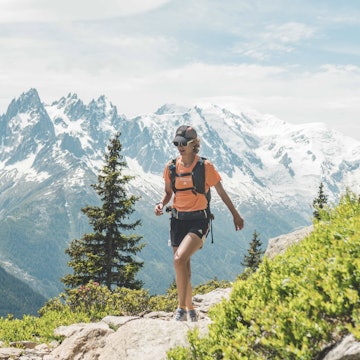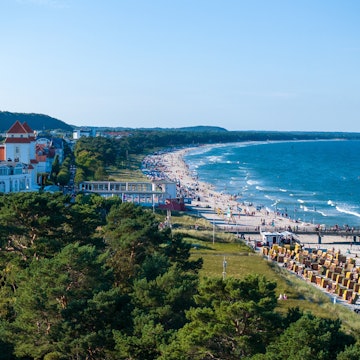

More green than black despite its name, the Black Forest is a star that just keeps on rising when it comes to eco-friendly initiatives, sustainable travel and conservation. With a new biosphere reserve, cities shining with solar power and mile upon spirit-lifting mile of diligently marked hiking and e-biking trails, this region has swiftly become one to watch.
Snuggled away in Germany’s southwest, the Black Forest has a timeless feel once you dive into its remotest reaches. Here in the lonely, tight-knit valleys where spruce forests bristle above dark-wood-shingle farms you’ll find scenes ripe for a Grimm bedtime story – not to mention the kind of off-the-radar solitude that’s becoming increasingly rare in an age of overtourism. Gigantic cuckoo clocks and chocolate-cherry gateaux have given the Schwarzwald global fame over the years, but in reality there’s far more to this neck of the woods than kitsch nostalgia and retro desserts.
Urban trailblazer: Freiburg
If the Black Forest has remained rooted to tradition in some ways, in others it is light-years ahead. Take Freiburg, for instance, a vivacious university city where medieval lanes fan out from an impressive Gothic minster. Just a gargoyle’s wink away from the French and Swiss borders, this is officially Germany’s sunniest city, and all of that solar energy has been put to clever use, with Freiburg installing more photovoltaic panels than any other German city – and more than some European countries.
The eco-trailblazer is home to the Solar Settlement in Freiburg’s Vauban quarter, the world’s first plus-energy, carbon-neutral living community, where homes make significant profit from green energy and bike routes and public transport take precedence over private cars. It’s a green, clean vision of a more sustainable future. For insight into how this neighbourhood ticks, stay the night at the ground-breaking Green City Hotel Vauban, whose impeccable environmental approach involves recycling, sourcing regional produce for meals, and building with energy-efficient materials.
Central Freiburg has upped its environmental game recently, too, with a new town hall designed by Ingenhoven Architects that flaunts a curving façade of photovoltaic cells. It has been hailed the world’s first public net-surplus-energy building.
Spotlight on conservation
Measuring 160km from tip to toe, the Black Forest spreads itself luxuriantly across thick forests of larch, fir and pine, river-carved valleys, and rippling hills that rise to mountains. Being green here comes as second nature to locals, but they’ve only really just woken up to the charms of their great outdoors.
In 2014, the Black Forest launched its first national park in the north of the region, between the chic thermal-spa town of Baden-Baden and Freudenstadt. Nature is largely left to its own devices in this wild 100-sq-km pocket of heather-brushed moorland and near-untouched coniferous forest. Its twisting centrepiece is the high-altitude Schwarzwaldhochstrasse (Black Forest Highway) on the B500, which makes for a ravishing road trip by e-vehicle, taking in layer upon layer of landscape and natural wonders like the Mummelsee, a forest-rimmed glacial cirque lake at the foot of 1164m Hornisgrinde.
More recent still is the arrival of the Black Forest’s Unesco Biosphere Reserve status, which now protects 632-sq-km of its precious woodland, hay meadows and moorland. Here wildlife is free to roam, human intervention is minimal and conservation is the watchword.
Go take a hike
Neighbouring Switzerland and Austria may have bagged the sky-scraping peaks, but there’s no place like the Black Forest for a walk in the woods. This region practically coined the concept of wandern (hiking), with the Schwarzwaldverein busily marking trails with red diamonds since 1864. And with a cool 23,000km of way-marked paths to explore today, many taking you deep into the national park and nature reserves, the question is not if you can hike but how.
Long before forest bathing became on trend, Waldeinsamkeit – the experience of being alone in and at one with the forest – was a thing here. And whether you’re watching the crisp morning light raking through the treetops, foraging for wild berries in a forest glade, or padding through snow on a twinkling Winterwanderweg (winter walking trail), this immense forest is perfect for slipping away from civilisation and feeling the restorative power of nature.
The 280km Westweg, stretching from Pforzheim in the northern Black Forest to Basel in Switzerland, is the long-distance dream. A shorter but scenic ramble is the 40km Panoramaweg above Baden-Baden, a high-level ridge trail weaving through orchards and woodlands, past waterfalls and viewpoints. Or head deeper into the mountains for a 12km hike on the Feldberg-Steig, which loops around 1493m Feldberg, the Black Forest’s highest peak, and crosses a nature reserve where you might sight chamois grazing. On cloud-free days, the views of the Alps from up here are glorious.
Should you wish to venture off-piste, the half-day hike from Gütenbach to Simonswäldertal on a silent forest trail opens up beautiful views and passes a sandstone figure of Christ that has grown into a tree. The 10km circular trail at Martinskapelle is just as lovely, affording incredible views of overlapping mountains and forest on repeat.
Get on your bike
You’ll find well-maintained cycle paths and forestry tracks practically everywhere you go in the Black Forest. The catch? The hills. A lot of the terrain involves at least an element of ascent, but you can always hop on an e-bike if you don't fancy the uphill slog. City, mountain and e-bikes are available for rental in most towns and villages, including in Freiburg. Or you can use the Deutsche Bahn Call a Bike service at train stations.
Once you’ve got your bike, a two-wheeled wonderland opens up, with choices ranging from gentle pedals along lakeshores to hardcore downhill tracks and multi-day road cycling routes. The 90km, mostly downhill Kinzigtal Radweg from Wolfach to Gengenbach is picture-book stuff, following a babbling river past half-timbered towns, through cherry orchards and up into hills ribboned with vineyards. A fine alternative is the 65km Murgtal-Radweg, from Freudenstadt to Rastatt on the Upper Rhine. Or if you want to cycle between borders, pedal from Freiburg along the Dreisam River west to Breisach and into Alsace in France.
Where to stay & eat
There are some wonderful green options when it comes to accommodation in the black Forest. Farm stays are sure-fire kid pleasers, often with farm animals to pet, organic dairy produce for sale, fine views, starry night skies and walking trails right on the doorstep. A one-stop shop is Urlaub auf dem Bauernhof, where farm stays are searchable by theme and area.
If you would prefer to camp, try an eco-aware site like Camping Langenwald in Freudenstadt, with a solar-heated pool, forest surrounds and nature trail. Or bed down for the night in a quirkily converted wine barrel Schlafen im Weinfass, located in Sasbachwalden in the national park. The Action Forest Active Hotel, close to Lake Titisee, makes a cracking base for outdoor activities, as does the Naturfreundehaus Feldberg, a back-to-nature farmhouse hostel using renewable energy.
For utter peace, dreamy forest views and some of the freshest home-fished trout you’ll ever taste, book a room at Höhengasthaus Kolmenhof at Martinskapelle, a characterful farmhouse right at the source of the Danube. More upscale is rustic-chic retreat Die Halde, gazing wistfully out over hill and vale and serving season-driven cuisine in its romantic wood-panelled restaurant. Dishes like venison with wild mushrooms and Spätzle (the local take on egg pasta) star on the menu.
Getting there & around
Germany’s high-speed trains mean you can reach the Black Forest quite easily from much of Europe without needing to fly. Strasbourg, a two-hour Eurostar journey from Paris, sits just across the border. When you stay overnight in many towns and villages, you automatically receive the KONUS guest card, which gives you free use of the extensive and efficient public transport network in the region.
https://shop.lonelyplanet.com/products/munich-bavaria-black-forest-travel-guide-6
















